Comprehensive Assessment and Mitigation of Indoor Air Quality in a Commercial Retail Building in Saudi Arabia
Abstract
1. Introduction
2. Significance of This Research
3. Research Methodology
3.1. Site Location
3.2. Data Collection and Sampling Strategy
3.3. Factors Measurement Techniques
3.4. Selection and Analysis of Pollutants
4. Results and Discussion
4.1. Carbon Monoxide Measurements
4.2. Carbon Dioxide Measurements
4.3. PM2.5 Measurements
4.4. Formaldehyde Measurements
4.5. Total Volatile Organic Compounds Measurement
4.6. Dynamics of Air Pollutants
5. Conclusions
Author Contributions
Funding
Institutional Review Board Statement
Informed Consent Statement
Data Availability Statement
Conflicts of Interest
References
- Kinney, P.L. Interactions of climate change, air pollution, and human health. Curr. Environ. Health Rep. 2018, 5, 179–186. [Google Scholar] [CrossRef] [PubMed]
- Reinmuth-Selzle, K.; Kampf, C.J.; Lucas, K.; Lang-Yona, N.; Fröhlich-Nowoisky, J.; Shiraiwa, M.; Lakey, P.S.; Lai, S.; Liu, F.; Kunert, A.T.; et al. Air pollution and climate change effects on allergies in the anthropocene: Abundance, interaction, and modification of allergens and adjuvants. Environ. Sci. Technol. 2017, 51, 4119–4141. [Google Scholar] [CrossRef] [PubMed]
- Höök, M.; Tang, X. Depletion of fossil fuels and anthropogenic climate change—A review. Energy Policy 2013, 52, 797–809. [Google Scholar] [CrossRef]
- Walters, R. Toxic atmospheres air pollution, trade and the politics of regulation. In Transnational Environmental Crime; Routledge: London, UK, 2017; pp. 321–338. [Google Scholar]
- Arbex, M.A.; Santos, U.D.P.; Martins, L.C.; Saldiva, P.H.N.; Pereira, L.A.A.; Braga, A.L.F. Air pollution and the respiratory system. J. Bras. Pneumol. 2012, 38, 643–655. [Google Scholar] [CrossRef]
- Saud, B.; Paudel, G. The threat of ambient air pollution in Kathmandu, Nepal. J. Environ. Public Health 2018, 2018, 04591. [Google Scholar] [CrossRef]
- World Health Organization. Air Quality Guidelines: Global Update 2005: Particulate Matter, Ozone, Nitrogen Dioxide, and Sulfur Dioxide; World Health Organization: Geneva, Switzerland, 2006. [Google Scholar]
- Zhang, K.; Batterman, S. Air pollution and health risks due to vehicle traffic. Sci. Total Environ. 2013, 450, 307–316. [Google Scholar] [CrossRef] [PubMed]
- Wang, J.; Wu, Q.; Liu, J.; Yang, H.; Yin, M.; Chen, S.; Guo, P.; Ren, J.; Luo, X.; Linghu, W.; et al. Vehicle emission and atmospheric pollution in China: Problems, progress, and prospects. PeerJ 2019, 7, e6932. [Google Scholar] [CrossRef]
- Badami, M.G. Transport and urban air pollution in India. Environ. Manag. 2005, 36, 195–204. [Google Scholar] [CrossRef]
- He, K.; Huo, H.; Zhang, Q. Urban air pollution in China: Current status, characteristics, and progress. Annu. Rev. Environ. Resour. 2002, 27, 397–431. [Google Scholar] [CrossRef]
- Brook, R.D.; Rajagopalan, S. Particulate matter air pollution and atherosclerosis. Curr. Atheroscler. Rep. 2010, 12, 291–300. [Google Scholar] [CrossRef]
- Peng, R.D.; Chang, H.H.; Bell, M.L.; McDermott, A.; Zeger, S.L.; Samet, J.M.; Dominici, F. Coarse particulate matter air pollution and hospital admissions for cardiovascular and respiratory diseases among Medicare patients. JAMA 2008, 299, 2172–2179. [Google Scholar] [CrossRef] [PubMed]
- Davidson, C.I.; Phalen, R.F.; Solomon, P.A. Airborne particulate matter and human health: A review. Aerosol Sci. Technol. 2005, 39, 737–749. [Google Scholar] [CrossRef]
- Kim, K.H.; Jahan, S.A.; Kabir, E.; Brown, R.J. A review of airborne polycyclic aromatic hydrocarbons (PAHs) and their human health effects. Environ. Int. 2013, 60, 71–80. [Google Scholar] [CrossRef]
- Abdel-Shafy, H.I.; Mansour, M.S. A review on polycyclic aromatic hydrocarbons: Source, environmental impact, effect on human health and remediation. Egypt. J. Pet. 2016, 25, 107–123. [Google Scholar] [CrossRef]
- Santijitpakdee, T.; Hongsibsong, S.; Boonyapranai, K.; Kulprachakarn, K.; Parklak, W.; Ounjaijean, S.; Kawichai, S. Polycyclic Aromatic Hydrocarbons (PAHs) in Household Dusts: Distribution, Sources, and Health Risk Assessment from Rural Areas in Chiang Mai Province, Thailand. Buildings 2025, 15, 1855. [Google Scholar] [CrossRef]
- Arif, I.; Adams, M.D.; Johnson, M.T. A meta-analysis of the carcinogenic effects of particulate matter and polycyclic aromatic hydrocarbons. Environ. Pollut. 2024, 351, 123941. [Google Scholar] [CrossRef]
- Lee, Y.K.; Lee, J.H.; Beak, N.G.; Kim, K.C.; Han, J.S. Seasonal and emission characteristics of PAHs in the ambient air of industrial complexes. Atmosphere 2023, 15, 30. [Google Scholar] [CrossRef]
- Zhang, X.; Li, Z. Investigating industrial PAH air pollution in relation to population exposure in major countries: A scoring approach. J. Environ. Manag. 2023, 338, 117801. [Google Scholar] [CrossRef]
- Tran, H.M.; Tsai, F.J.; Lee, Y.L.; Chang, J.H.; Chang, L.T.; Chang, T.Y.; Chung, K.F.; Kuo, H.P.; Lee, K.Y.; Chuang, K.J.; et al. The impact of air pollution on respiratory diseases in an era of climate change: A review of the current evidence. Sci. Total Environ. 2023, 898, 166340. [Google Scholar] [CrossRef]
- Lu, C.W.; Fu, J.; Liu, X.F.; Chen, W.W.; Hao, J.L.; Li, X.L.; Pant, O.P. Air pollution and meteorological conditions significantly contribute to the worsening of allergic conjunctivitis: A regional 20-city, 5-year study in Northeast China. Light Sci. Appl. 2021, 10, 190. [Google Scholar] [CrossRef]
- Henning, R.J. Particulate Matter Air Pollution is a Significant Risk Factor for Cardiovascular Disease. Curr. Probl. Cardiol. 2024, 49 Pt B, 102094. [Google Scholar] [CrossRef]
- Rosário Filho, N.A.; Urrutia-Pereira, M.; d’Amato, G.; Cecchi, L.; Ansotegui, I.J.; Galán, C.; Pomés, A.; Murrieta-Aguttes, M.; Caraballo, L.; Rouadi, P.; et al. Air pollution and indoor settings. World Allergy Organ. J. 2021, 14, 100499. [Google Scholar] [CrossRef] [PubMed]
- Schraufnagel, D.E.; Balmes, J.R.; Cowl, C.T.; De Matteis, S.; Jung, S.H.; Mortimer, K.; Perez-Padilla, R.; Rice, M.B.; Riojas-Rodriguez, H.; Sood, A.; et al. Air Pollution and Noncommunicable Diseases: A Review by the Forum of International Respiratory Societies’ Environmental Committee, Part 1: The Damaging Effects of Air Pollution. Chest 2019, 155, 409–416. [Google Scholar] [CrossRef]
- Ghaffarianhoseini, A.; AlWaer, H.; Omrany, H.; Ghaffarianhoseini, A.; Alalouch, C.; Clements-Croome, D.; Tookey, J. Sick building syndrome: Are we doing enough? Archit. Sci. Rev. 2018, 61, 99–121. [Google Scholar] [CrossRef]
- Mastrucci, A.; van Ruijven, B.; Byers, E.; Poblete-Cazenave, M.; Pachauri, S. Global scenarios of residential heating and cooling energy demand and CO2 emissions. Clim. Change 2021, 168, 1–26. [Google Scholar] [CrossRef]
- Liu, Z.; Jiang, G. Optimization of intelligent heating ventilation air conditioning system in urban building based on BIM and artificial intelligence technology. Comput. Sci. Inf. Syst. 2021, 18, 1379–1394. [Google Scholar] [CrossRef]
- Asim, N.; Badiei, M.; Mohammad, M.; Razali, H.; Rajabi, A.; Chin Haw, L.; Jameelah Ghazali, M. Sustainability of heating, ventilation and air-conditioning (HVAC) systems in buildings—An overview. Int. J. Environ. Res. Public Health 2022, 19, 1016. [Google Scholar] [CrossRef] [PubMed]
- Wargocki, P.; Wyon, D.P.; Baik, Y.K.; Clausen, G.; Fanger, P.O. Perceived air quality, sick building syndrome (SBS) symptoms and productivity in an office with two different pollution loads. Indoor Air 1999, 9, 165–179. [Google Scholar] [CrossRef] [PubMed]
- Nordström, K.; Norbäck, D.; Akselsson, R. Influence of indoor air quality and personal factors on the sick building syndrome (SBS) in Swedish geriatric hospitals. Occup. Environ. Med. 1995, 52, 170–176. [Google Scholar] [CrossRef]
- Sarkhosh, M.; Najafpoor, A.A.; Alidadi, H.; Shamsara, J.; Amiri, H.; Andrea, T.; Kariminejad, F. Indoor Air Quality associations with sick building syndrome: An application of decision tree technology. Build. Environ. 2021, 188, 107446. [Google Scholar] [CrossRef]
- Al-Thani, H.G.; Isaifan, R.J. Policies and Regulations for Sustainable Clean Air: A Comprehensive Overview. In Sustainable Strategies for Air Pollution Mitigation; Springer: Cham Switzerland, 2024; pp. 409–437. [Google Scholar]
- Liu, Y.; Wu, J.; Yi, H.; Wen, J. Under what conditions do governments collaborate? A qualitative comparative analysis of air pollution control in China. Public Manag. Rev. 2021, 23, 1664–1682. [Google Scholar] [CrossRef]
- Kwilinski, A.; Lyulyov, O.; Pimonenko, T. Reducing transport sector CO2 emissions patterns: Environmental technologies and renewable energy. J. Open Innov. Technol. Mark. Complex. 2024, 10, 100217. [Google Scholar] [CrossRef]
- Dai, J.; Alvarado, R.; Ali, S.; Ahmed, Z.; Meo, M.S. Transport infrastructure, economic growth, and transport CO2 emissions nexus: Does green energy consumption in the transport sector matter? Environ. Sci. Pollut. Res. 2023, 30, 40094–40106. [Google Scholar] [CrossRef] [PubMed]
- Lu, J.; Li, B.; Li, H.; Al-Barakani, A. Expansion of city scale, traffic modes, traffic congestion, and air pollution. Cities 2021, 108, 102974. [Google Scholar] [CrossRef]
- Nieuwenhuijsen, M.J. New urban models for more sustainable, liveable and healthier cities post COVID-19; Reducing air pollution, noise and heat island effects and increasing green space and physical activity. Environ. Int. 2021, 157, 106850. [Google Scholar] [CrossRef] [PubMed]
- Mouratidis, K. Urban planning and quality of life: A review of pathways linking the built environment to subjective well-being. Cities 2021, 115, 103229. [Google Scholar] [CrossRef]
- Teh, K.J.L.; Razali, H.; Lim, C.H. Field Investigation of Thermal Comfort and Indoor Air Quality Analysis Using a Multi-Zone Approach in a Tropical Hypermarket. Buildings 2025, 15, 1677. [Google Scholar] [CrossRef]
- Baptista, T.; Almeida-Silva, M.; Silva, D.; Diogo, C.; Canha, N. Indoor Air Quality Assessment in Grocery Stores. Appl. Sci. 2022, 12, 12940. [Google Scholar] [CrossRef]
- Naidoo, M.; Gasparatos, A. Consumer worldviews and perspectives on environmental sustainability initiatives in the South African supermarket sector. J. Clean. Prod. 2023, 413, 137496. [Google Scholar] [CrossRef]
- Seo, S.H.; Jung, K.S.; Park, M.K.; Kwon, H.O.; Choi, S.D. Indoor air pollution of polycyclic aromatic hydrocarbons emitted by computers. Build. Environ. 2022, 218, 109107. [Google Scholar] [CrossRef]
- Nga, L.P.; Tam, P.T. Managerial recommendations for enhancing green consumption behavior and sustainable consumption. Emerg. Sci. J. 2024, 8, 2245–2266. [Google Scholar] [CrossRef]
- Pongpunpurt, P.; Chawaloesphonsiya, N.; Poyai, T.; Guiraud, P.; Tiruta-Barna, L.; Rungsithong, R.; Leknoi, U.; Janjaroen, D.; Painmanakul, P. Exploring the circular business model for sustainable plastic waste management in shopping malls: Challenges, opportunities, and impacts in Thailand. Case Stud. Chem. Environ. Eng. 2024, 10, 100872. [Google Scholar] [CrossRef]
- Robert, L.; Guichard, R.; Klingler, J.; Cochet, V.; Mandin, C. Indoor air quality in shopping and storage areas. Indoor Air 2021, 31, 1238–1251. [Google Scholar] [CrossRef]
- Furst, L.; Cipoli, Y.; Galindo, N.; Yubero, E.; Viegas, C.; Pena, P.; Nunes, T.; Feliciano, M.; Alves, C. Comprehensive analysis of particulate matter, gaseous pollutants, and microbiological contamination in an international chain supermarket. Environ. Pollut. 2024, 363, 125236. [Google Scholar] [CrossRef] [PubMed]
- D’Agostino, D.; Minelli, F.; Minichiello, F.; Musella, M. Improving the indoor air quality of office buildings in the post-pandemic era—Impact on energy consumption and costs. Energies 2024, 17, 855. [Google Scholar] [CrossRef]
- Kumari, S.; Jain, M.K. A critical review on air quality index. In Environmental Pollution: Select Proceedings of ICWEES-2016; Springer: Singapore, 2018; pp. 87–102. [Google Scholar]
- Mendell, M.J.; Chen, W.; Ranasinghe, D.R.; Castorina, R.; Kumagai, K. Carbon dioxide guidelines for indoor air quality: A review. J. Expo. Sci. Environ. Epidemiol. 2024, 34, 555–569. [Google Scholar] [CrossRef]
- Omeokachie, D.N.; Ana, G.R.; Laniyan, T.A.; Olawade, D.B.; Abaire, O.J.; Esan, D.T. Sanitary conditions, waste management, safety measures and sources of air pollution associated with shopping malls in Nigeria’s largest city. Public Health Pract. 2023, 5, 100376. [Google Scholar] [CrossRef]
- Bogdanovica, S.; Zemitis, J.; Bogdanovics, R. The effect of CO2 concentration on children’s well-being during the process of learning. Energies 2020, 13, 6099. [Google Scholar] [CrossRef]
- Othman, M.; Latif, M.T.; Yee, C.Z.; Norshariffudin, L.K.; Azhari, A.; Halim, N.D.A.; Alias, A.; Sofwan, N.M.; Abd Hamid, H.H.; Matsumi, Y. PM2. 5 and ozone in office environments and their potential impact on human health. Ecotoxicol. Environ. Saf. 2020, 194, 110432. [Google Scholar] [CrossRef]
- Lei, T.M.; Chan, Y.W.; Nadzir, M.S.M. Monitoring PM2. 5 at a Large Shopping Mall: A Case Study in Macao. Processes 2023, 11, 914. [Google Scholar] [CrossRef]
- Liu, S.; Song, R.; Zhang, T.T. Residential building ventilation in situations with outdoor PM2.5 pollution. Build. Environ. 2021, 202, 108040. [Google Scholar] [CrossRef]
- Gilbert, N.L.; Gauvin, D.; Guay, M.; Héroux, M.È.; Dupuis, G.; Legris, M.; Chan, C.C.; Dietz, R.N.; Lévesque, B. Housing characteristics and indoor concentrations of nitrogen dioxide and formaldehyde in Quebec City, Canada. Environ. Res. 2006, 102, 1–8. [Google Scholar] [CrossRef] [PubMed]
- Nielsen, G.D.; Larsen, S.T.; Wolkoff, P. Re-evaluation of the WHO (2010) formaldehyde indoor air quality guideline for cancer risk assessment. Arch. Toxicol. 2017, 91, 35–61. [Google Scholar] [CrossRef] [PubMed]
- World Health Organization. WHO Global Air Quality Guidelines, Articulate Matter (PM2.5 and PM10), Ozone, Nitrogen Dioxide, Sulfur Dioxide and Carbon Monoxide; Executive Summary; World Health Organization: Geneva, Switzerland, 2021. [Google Scholar]
- Tong, X.; Wang, B.; Dai, W.T.; Cao, J.J.; Ho, S.S.H.; Kwok, T.C.; Lui, K.H.; Lo, C.M.; Ho, K.F. Indoor air pollutant exposure and determinant factors controlling household air quality for elderly people in Hong Kong. Air Qual. Atmos. Health 2018, 11, 695–704. [Google Scholar] [CrossRef]
- Rovira, J.; Roig, N.; Nadal, M.; Schuhmacher, M.; Domingo, J.L. Human health risks of formaldehyde indoor levels: An issue of concern. J. Environ. Sci. Health Part A 2016, 51, 357–363. [Google Scholar] [CrossRef]
- Kotzias, D. Built environment and indoor air quality: The case of volatile organic compounds. AIMS Environ. Sci. 2021, 8, 135–147. [Google Scholar] [CrossRef]
- Bayati, M.; Vu, D.C.; Vo, P.H.; Rogers, E.; Park, J.; Ho, T.L.; Davis, A.N.; Gulseven, Z.; Carlo, G.; Palermo, F.; et al. Health risk assessment of volatile organic compounds at daycare facilities. Indoor Air 2021, 31, 977–988. [Google Scholar] [CrossRef]
- Wickliffe, J.K.; Stock, T.H.; Howard, J.L.; Frahm, E.; Simon-Friedt, B.R.; Montgomery, K.; Wilson, M.J.; Lichtveld, M.Y.; Harville, E. Increased long-term health risks attributable to select volatile organic compounds in residential indoor air in southeast Louisiana. Sci. Rep. 2020, 10, 21649. [Google Scholar] [CrossRef]
- Kim, J.; Shim, I.K.; Won, S.R.; Hwang, E.S.; Lee, Y.; Park, S.; Ryu, J.; Lee, J. Indoor air quality and its determinants in underground shopping malls in Korea. Environ. Int. 2024, 183, 108395. [Google Scholar] [CrossRef]
- Piasecki, M.; Kostyrko, K.B.; Goljan, A. The ability to control VOC emissions from multilayer building materials. Appl. Sci. 2021, 11, 4806. [Google Scholar] [CrossRef]
- Mannan, M.; Al-Ghamdi, S.G. Indoor air quality in buildings: A comprehensive review on the factors influencing air pollution in residential and commercial structure. Int. J. Environ. Res. Public Health 2021, 18, 3276. [Google Scholar] [CrossRef] [PubMed]
- Vardoulakis, S.; Giagloglou, E.; Steinle, S.; Davis, A.; Sleeuwenhoek, A.; Galea, K.S.; Dixon, K.; Crawford, J.O. Indoor exposure to selected air pollutants in the home environment: A systematic review. Int. J. Environ. Res. Public Health 2020, 17, 8972. [Google Scholar] [CrossRef] [PubMed]
- Nandan, A.; Siddiqui, N.A.; Singh, C.; Aeri, A. Occupational and environmental impacts of indoor air pollutant for different occupancy: A review. Toxicol. Environ. Health Sci. 2021, 13, 303–322. [Google Scholar] [CrossRef]
- Widder, S.H.; Haselbach, L. Relationship among concentrations of indoor air contaminants, their sources, and different mitigation strategies on indoor air quality. Sustainability 2017, 9, 1149. [Google Scholar] [CrossRef]
- Essamlali, I.; Nhaila, H.; El Khaili, M. Supervised machine learning approaches for predicting key pollutants and for the sustainable enhancement of urban air quality: A systematic review. Sustainability 2024, 16, 976. [Google Scholar] [CrossRef]
- Rahaman, M.A.; Kalam, A.; Al-Mamun, M. Unplanned urbanization and health risks of Dhaka City in Bangladesh: Uncovering the associations between urban environment and public health. Front. Public Health 2023, 11, 1269362. [Google Scholar] [CrossRef]
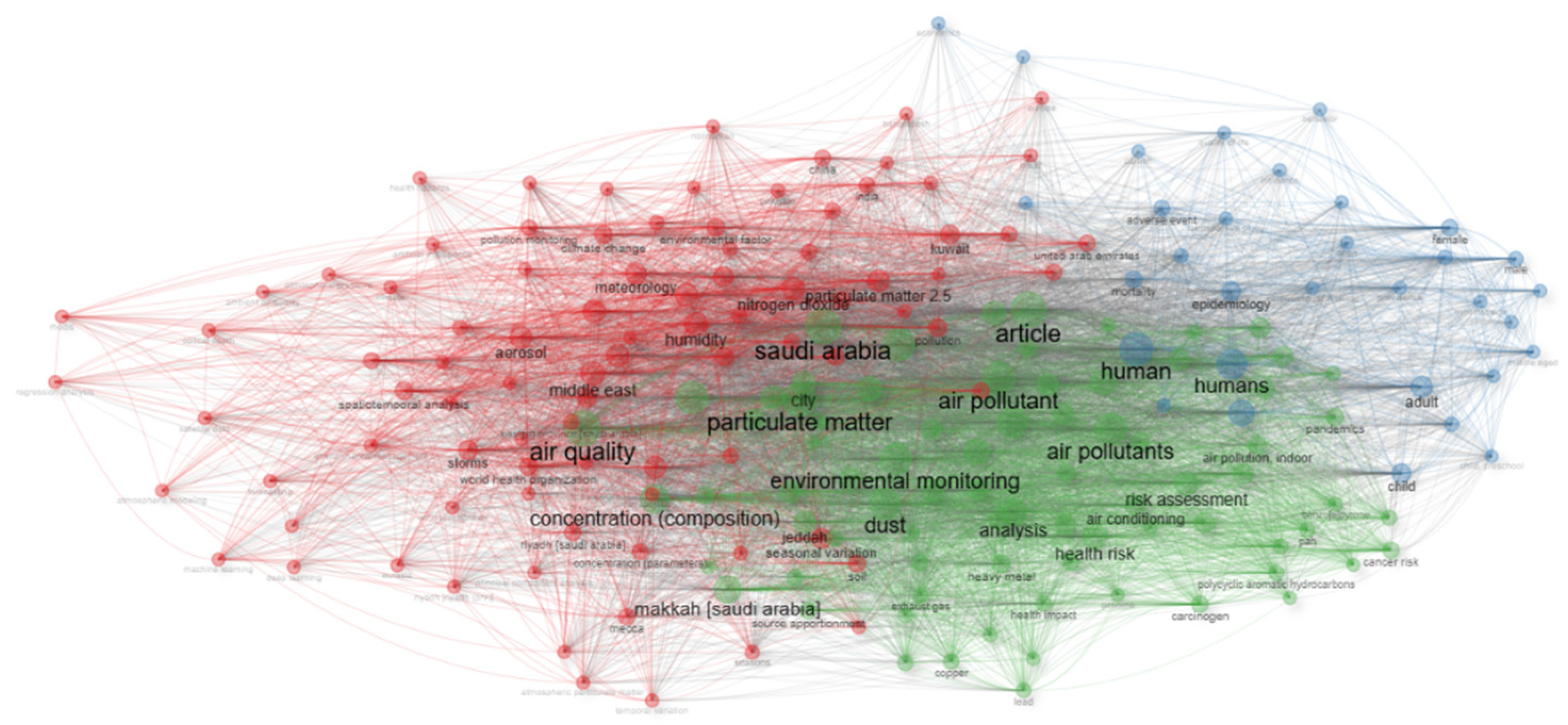
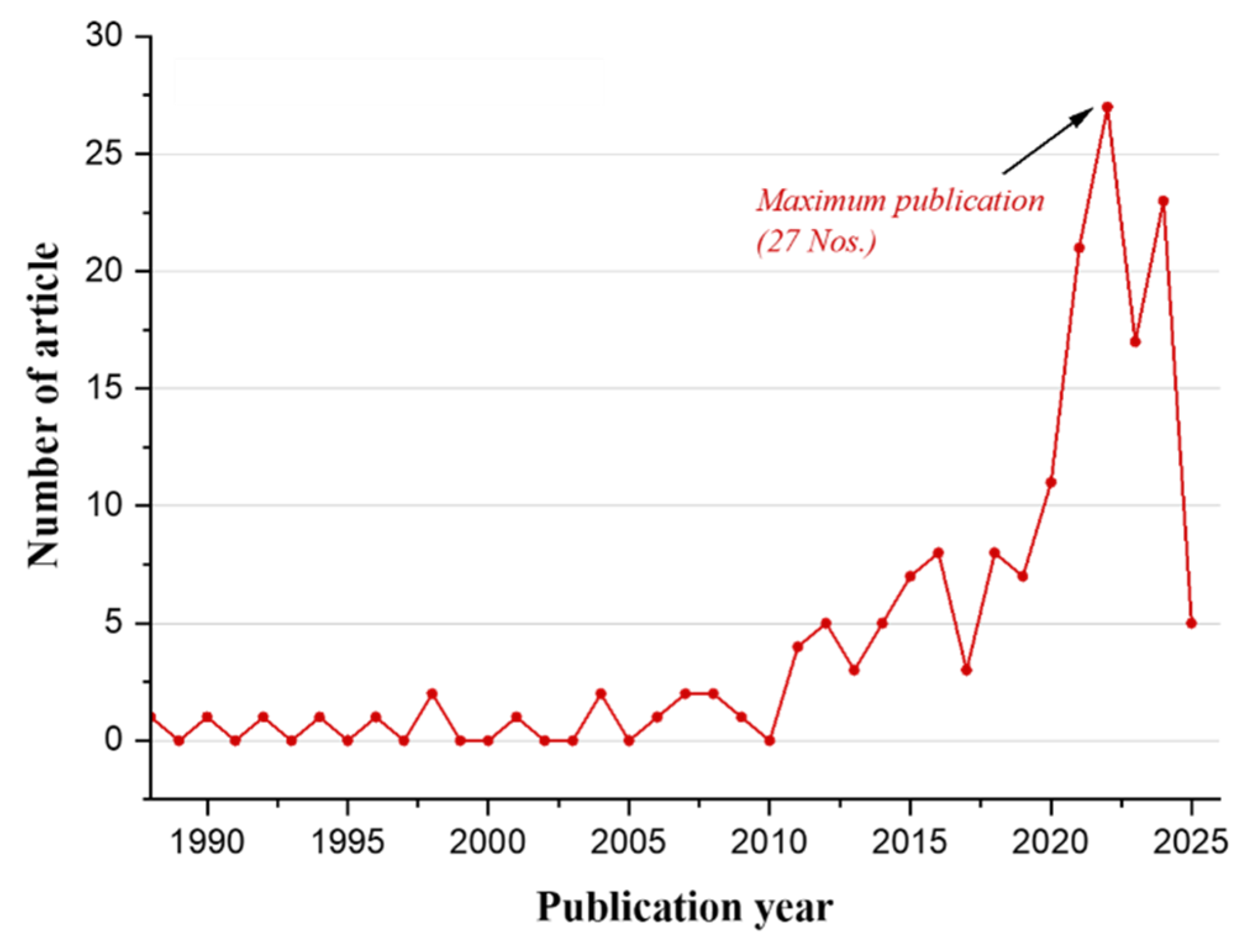

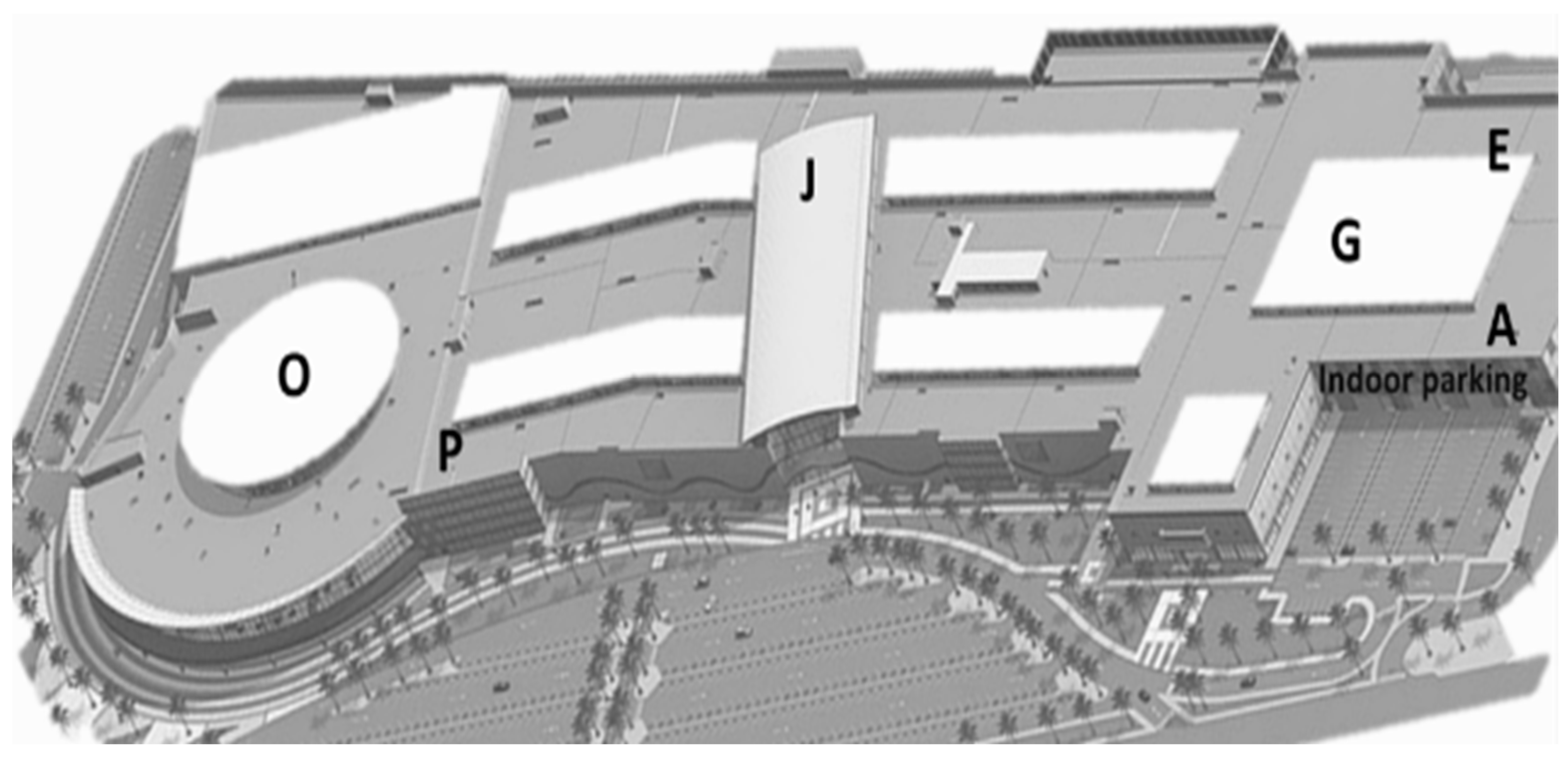
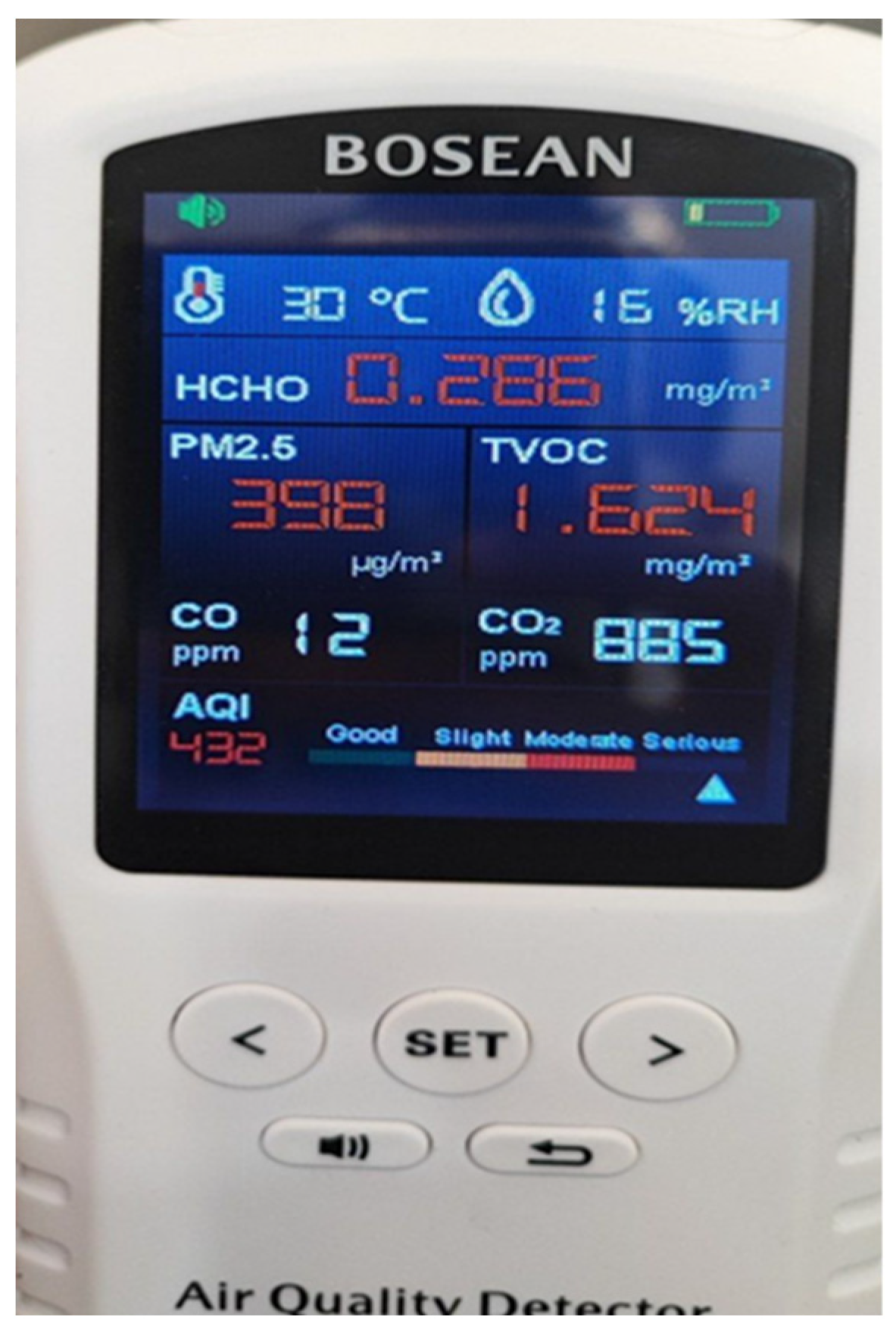
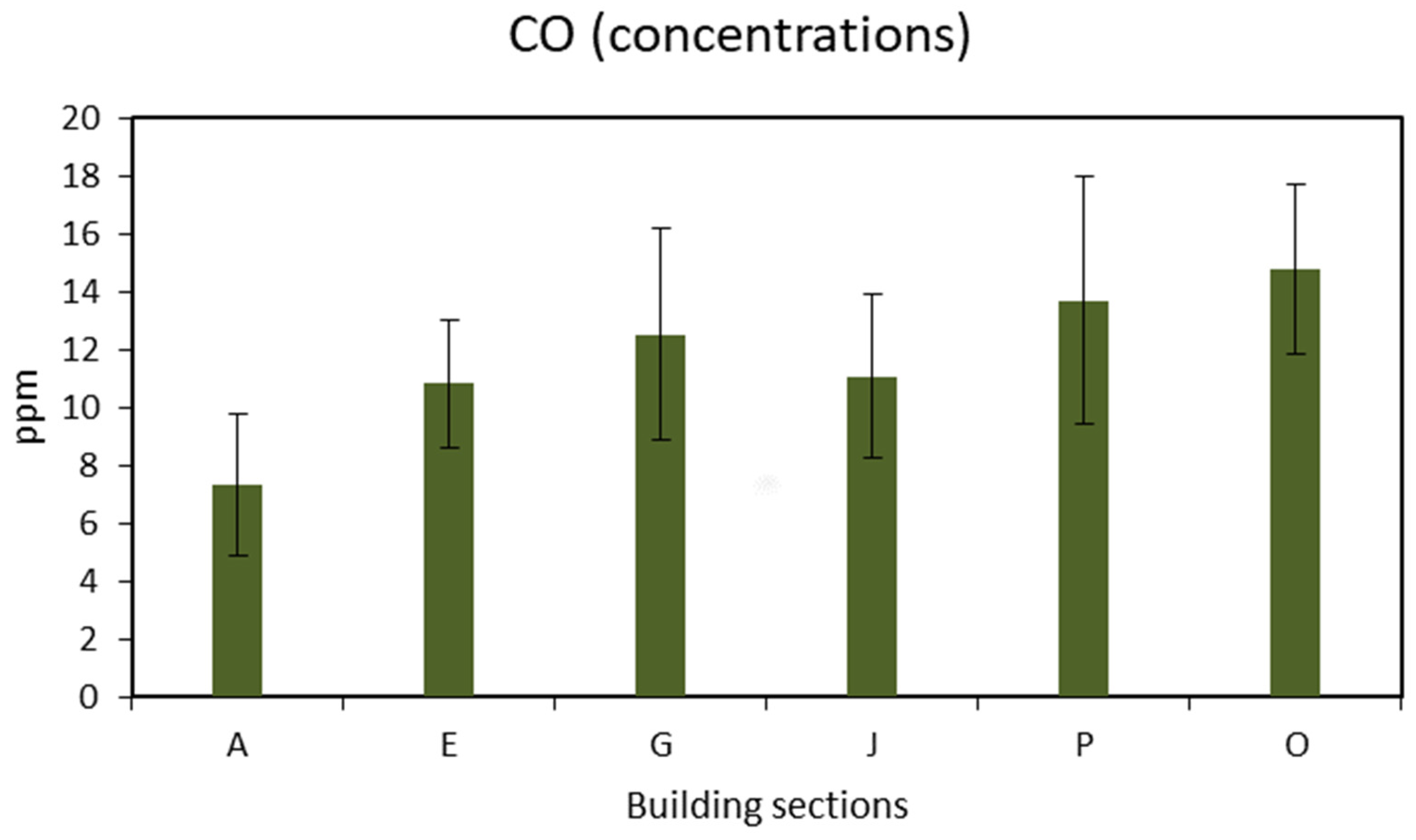
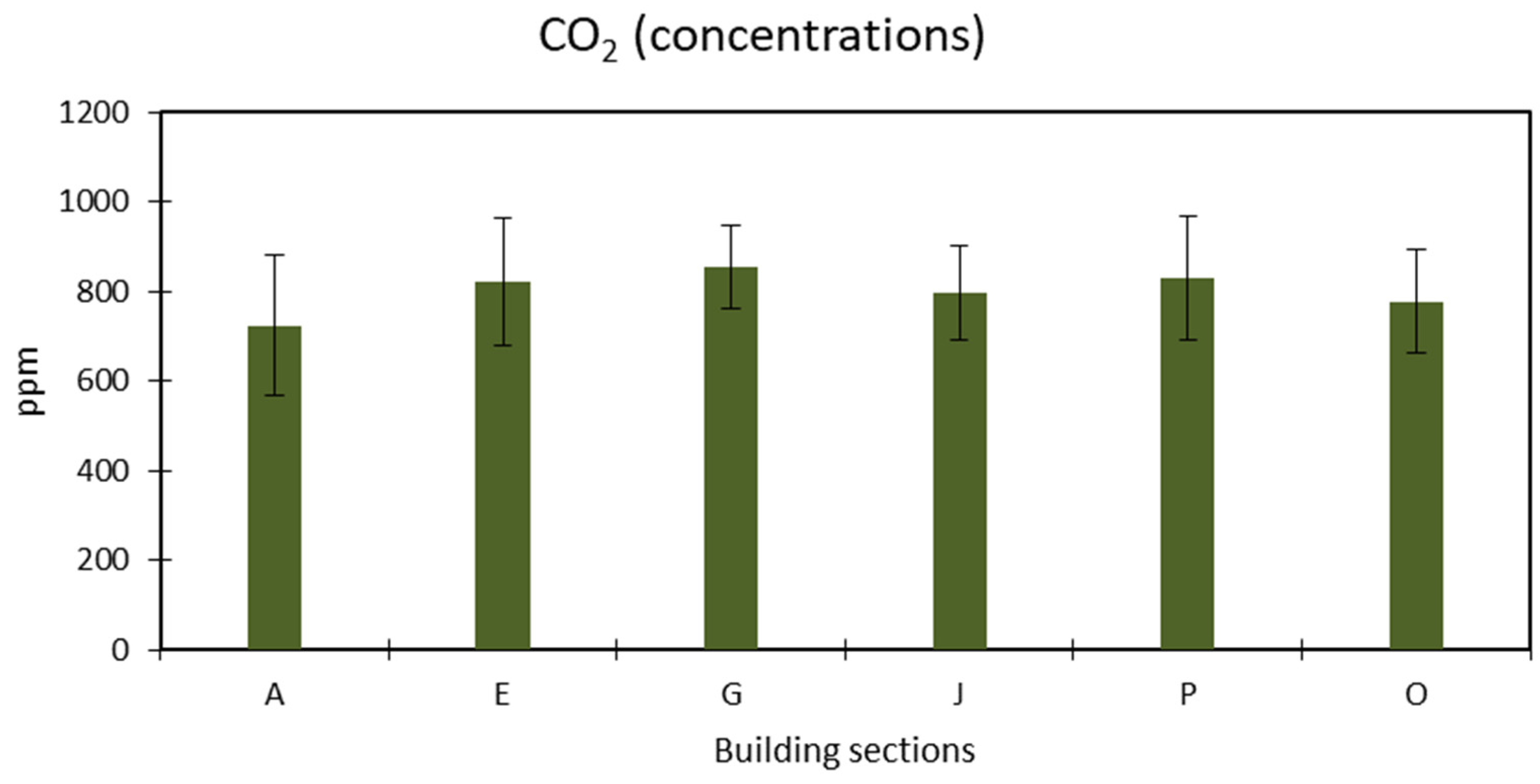
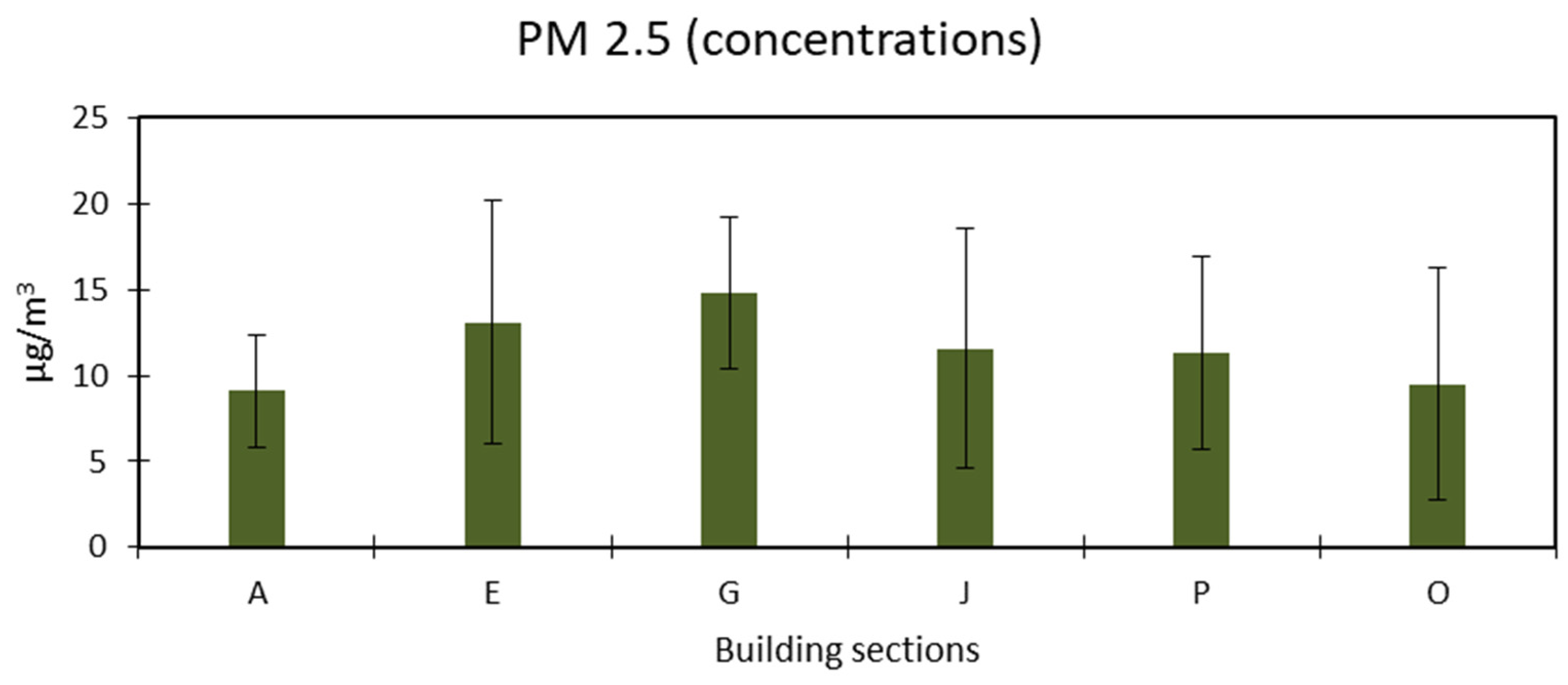
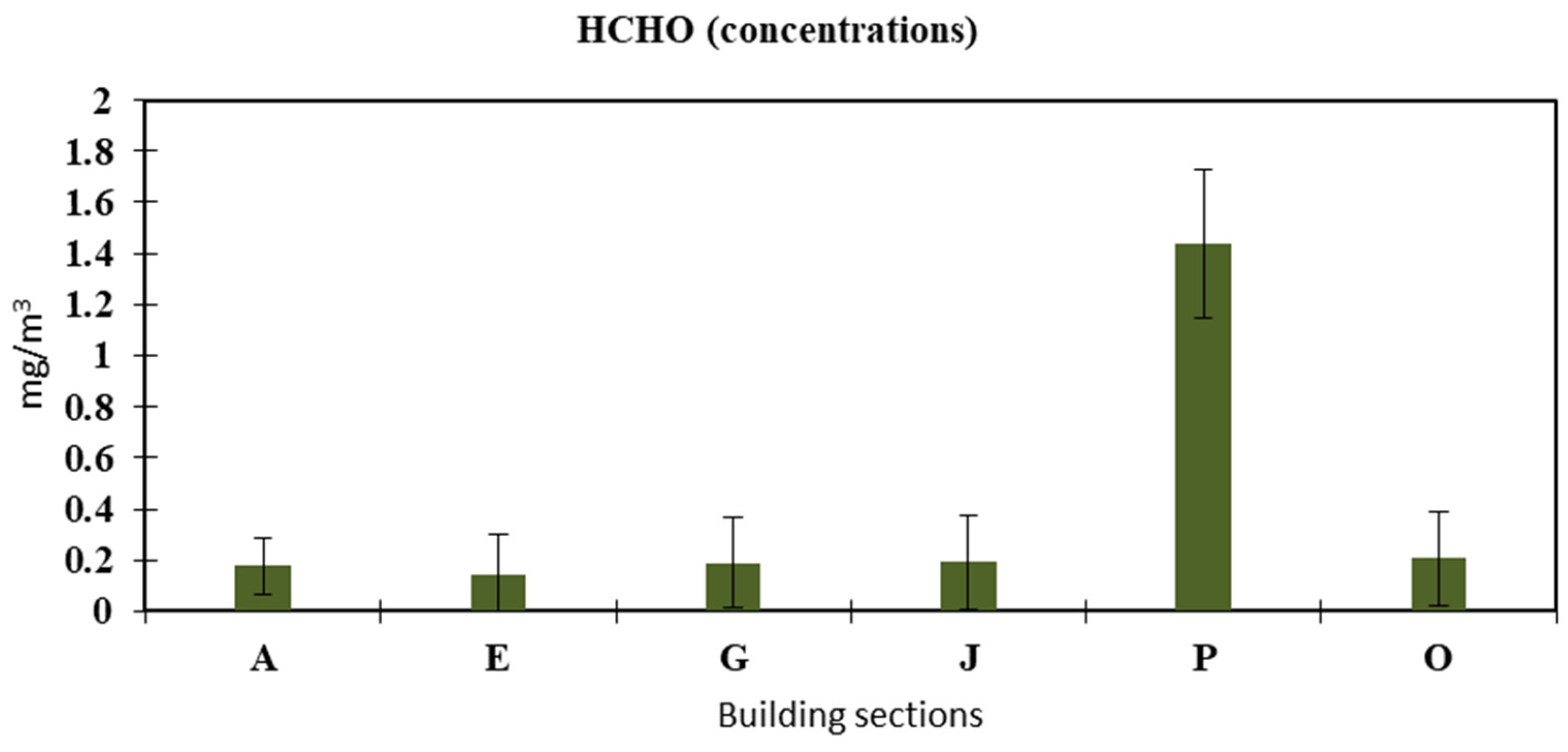
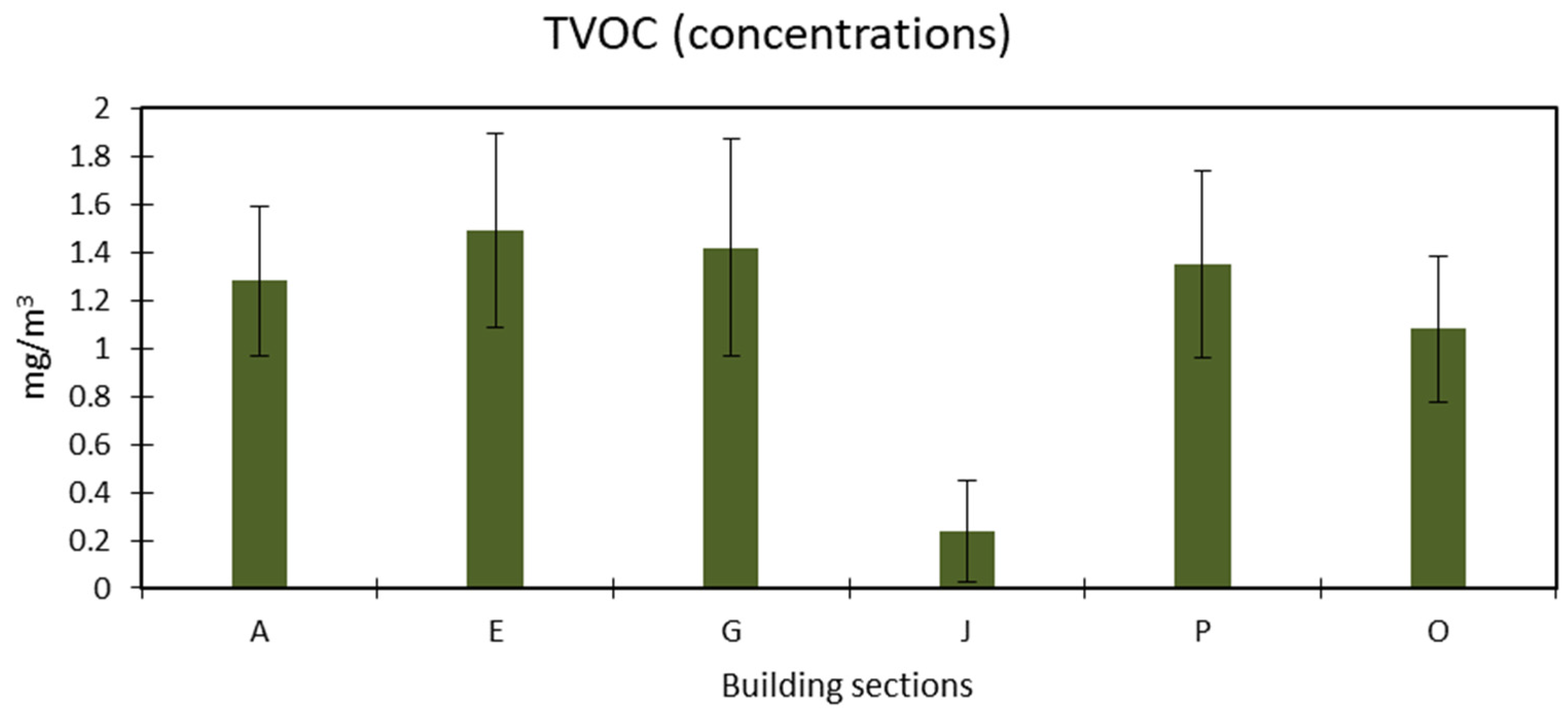
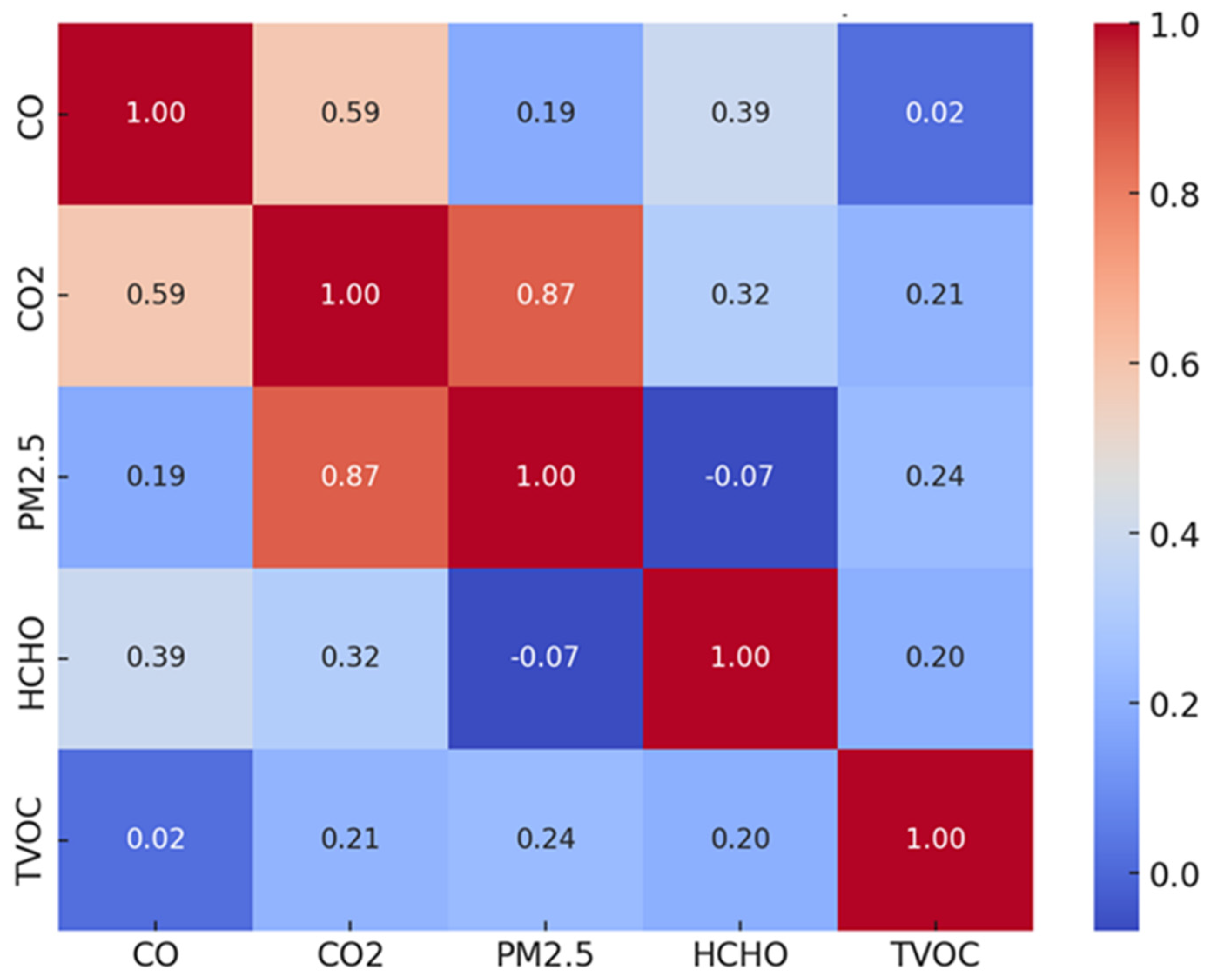
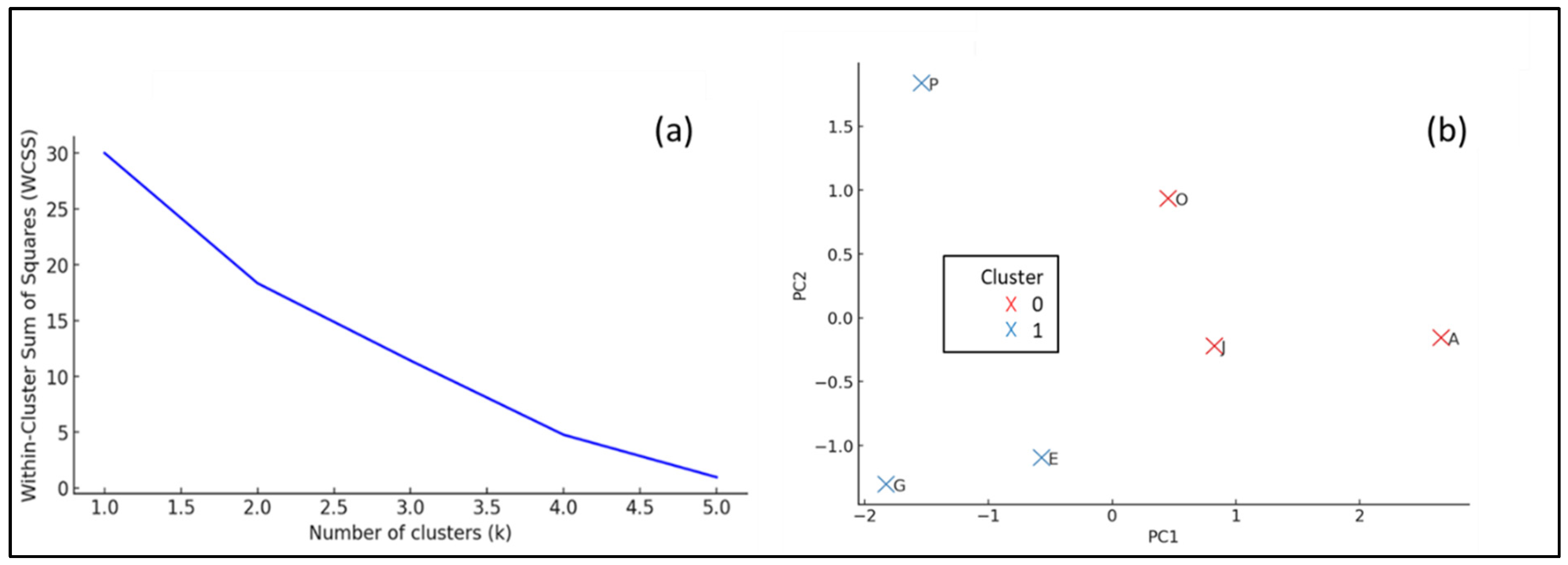
| Parameters | Pollutants | Measurement Range |
|---|---|---|
| Range | PM2.5 | 0~999.9 μg/m3 |
| HCHO | 0–1.00 mg/m3 | |
| TVOCs | 0–10 mg m3 | |
| Resolution | PM2.5 | 0.1 μg/m3 |
| HCHO | 0.01 mg/m3 | |
| TVOCs | 0.05 mg/m3 | |
| Detection range | HCHO | 0–0.999 mg/m3 |
| TVOCs | 0–9.999 mg/m3 | |
| PM2.5 | 0–999 μg/m3 |
Disclaimer/Publisher’s Note: The statements, opinions and data contained in all publications are solely those of the individual author(s) and contributor(s) and not of MDPI and/or the editor(s). MDPI and/or the editor(s) disclaim responsibility for any injury to people or property resulting from any ideas, methods, instructions or products referred to in the content. |
© 2025 by the authors. Licensee MDPI, Basel, Switzerland. This article is an open access article distributed under the terms and conditions of the Creative Commons Attribution (CC BY) license (https://creativecommons.org/licenses/by/4.0/).
Share and Cite
Al-Rashed, W.S.; Lakhouit, A. Comprehensive Assessment and Mitigation of Indoor Air Quality in a Commercial Retail Building in Saudi Arabia. Sustainability 2025, 17, 5862. https://doi.org/10.3390/su17135862
Al-Rashed WS, Lakhouit A. Comprehensive Assessment and Mitigation of Indoor Air Quality in a Commercial Retail Building in Saudi Arabia. Sustainability. 2025; 17(13):5862. https://doi.org/10.3390/su17135862
Chicago/Turabian StyleAl-Rashed, Wael S., and Abderrahim Lakhouit. 2025. "Comprehensive Assessment and Mitigation of Indoor Air Quality in a Commercial Retail Building in Saudi Arabia" Sustainability 17, no. 13: 5862. https://doi.org/10.3390/su17135862
APA StyleAl-Rashed, W. S., & Lakhouit, A. (2025). Comprehensive Assessment and Mitigation of Indoor Air Quality in a Commercial Retail Building in Saudi Arabia. Sustainability, 17(13), 5862. https://doi.org/10.3390/su17135862







